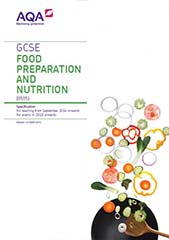3.1 Food preparation skills
Twelve skill groups have been integrated throughout the specification to show how the content can be taught through practical activities. These skills are not intended to be taught separately from the main content, but integrated into schemes of work. The skill groups are indicated in the subject content, using the references S1 (Skill 1), S2 (Skill 2) etc.
Students must know how and when these food preparation skills can be applied and combined to achieve specific outcomes. The choice of recipes to exemplify the skills will be at the discretion of the school or college, although some recipe suggestions have been included as suitable examples.
Skill 1: General practical skills
|
Food preparation skills |
Techniques |
|---|---|
|
Weigh and measure |
Accurate measurement of liquids and solids. |
|
Prepare ingredients and equipment |
Grease/oil, line, flour, evenly and with attention to finished product. |
|
Select and adjust cooking times |
Select and adjust the cooking process and length of time to suit the ingredient, for example to match the cut of meat, fish and alternatives. |
|
Test for readiness |
Use a temperature probe, knife, skewer, finger or poke test, bite, visual colour check or sound to establish whether an ingredient or recipe is ready. |
|
Judge and modify sensory properties |
|
Skill 2: Knife skills
|
Food preparation skills |
Techniques |
|---|---|
|
Fruit and vegetables |
Bridge hold, claw grip, peel, slice, dice and cut into even size pieces (ie batons, julienne). |
|
Meat, fish or alternatives |
Fillet a chicken breast, portion a chicken, remove fat and rind, fillet fish, slice evenly and accurately: raw and cooked meat and fish or alternatives (such as tofu and halloumi cheese). |
Skill 3: Preparing fruit and vegetables
|
Food preparation skills |
Techniques |
|---|---|
|
Preparing fruit and vegetables |
Mash, shred, scissor snip, scoop, crush, grate, peel, segment, de-skin, de-seed, blanch, shape, pipe, blend, juice and prepare garnishes whilst demonstrating the technical skills of controlling enzymic browning, spoilage and preventing food poisoning (wash and dry where appropriate). |
Skill 4: Use of the cooker
|
Food preparation skills |
Techniques |
|---|---|
|
Using the grill |
Use a range of foods, such as vegetables, meat, fish or alternatives such as halloumi, seeds and nuts; char/grill or toast. |
|
Using the oven |
Baking, roasting, casseroles and/or tagines, braising. |
Skill 5: Use of equipment
|
Food preparation skills |
Techniques |
|---|---|
|
Using equipment |
Use of blender, food processor, mixer, pasta machine, microwave oven. |
Skill 6: Cooking methods
|
Food preparation skills |
Techniques |
|---|---|
|
Water based methods using the hob |
Steaming, boiling and simmering; blanching; poaching. |
|
Dry heat and fat based methods using the hob |
Dry frying, shallow frying, stir frying. |
Skill 7: Prepare, combine and shape
|
Food preparation skills |
Techniques |
|---|---|
|
Prepare, combine and shape |
Roll, wrap, skewer, mix, coat, layer meat, fish and alternatives. Shape and bind wet mixtures (such as falafels, burgers, fish cakes or meatballs) whilst demonstrating the technical skill of preventing cross contamination and handling high risk foods correctly. |
Skill 8: Sauce making
|
Food preparation skills |
Techniques |
|---|---|
|
Starch based |
Sauce demonstrating starch gelatinisation such as: roux, all in one, blended, infused velouté or béchamel. How starch/liquid ratios affect viscosity. |
|
Reduction |
Reduction sauce to show how evaporation concentrates flavour. Eg tomato pasta sauce, curry sauce, gravy, meat sauce (including meat alternatives such as mycoprotein and textured vegetable protein) to show how evaporation concentrates flavour and changes the viscosity of the sauce. |
|
Emulsion |
Make an emulsion sauce such as a salad dressing, demonstrating an understanding of how to stabilise an emulsion. |
Skill 9: Tenderise and marinate
|
Food preparation skills |
Techniques |
|---|---|
| Tenderise and marinate |
|
Skill 10: Dough
|
Food preparation skills |
Techniques |
|---|---|
|
Making a dough (bread, pastry, pasta) |
Use technical skills of shortening, gluten formation, fermentation (proving) for bread, pastry, pasta. |
|
Shaping and finishing |
Roll out pastry, use a pasta machine, line a flan ring, create layers (palmiers) proving and resting, glazing and finishing, such as pipe choux pastry, bread rolls, pasta, flat breads, pinwheels, pizza and calzone. |
Skill 11: Raising agents
|
Food preparation skills |
Techniques |
|---|---|
|
Eggs as a raising agent |
Create a gas-in-liquid foam, whisking egg whites, whisked sponge. |
|
Chemical raising agents |
The use of self raising flour, baking powder, bicarbonate of soda. |
|
Steam as a raising agent |
Use of steam in a mixture (choux pastry, batter). |
|
Biological raising agent |
Use of yeast in breadmaking. |
Skill 12: Setting mixtures
|
Food preparation skills |
Techniques |
|---|---|
|
Removal of heat |
Gelation: use a starch to set a mixture on chilling for layered desserts such as custard. |
|
Use protein |
Set a mixture on heating such as denatured and/or coagulated protein in eggs. |
